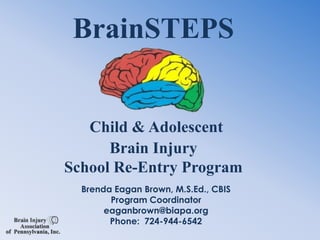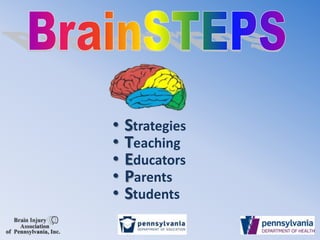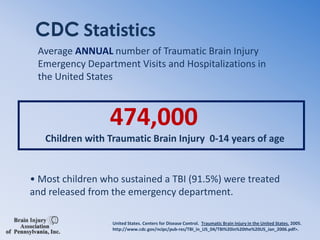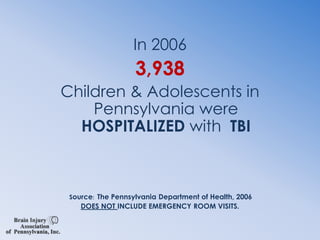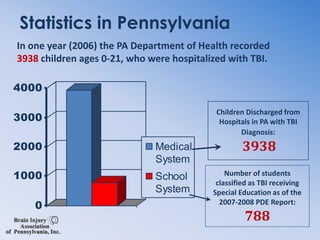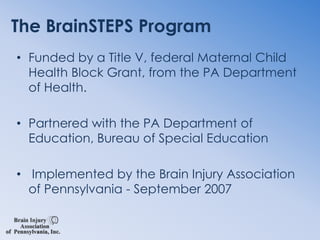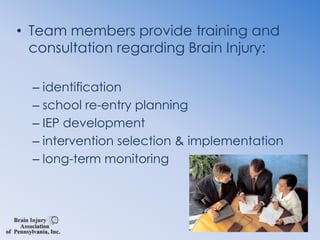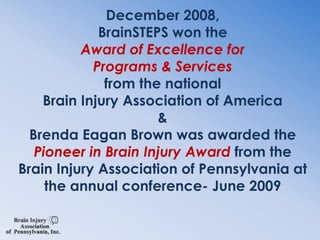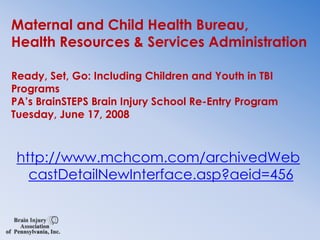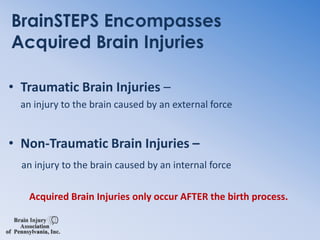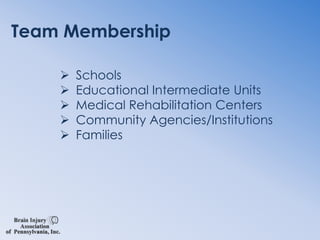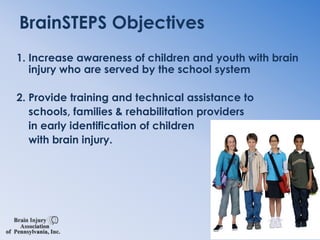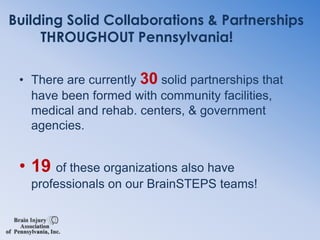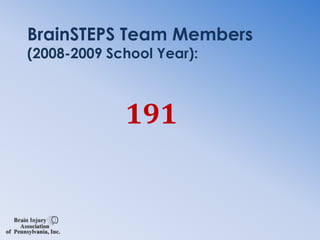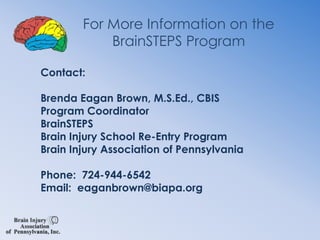The BrainSTEPS Brain Injury School Re-Entry Program
- 1. BrainSTEPSChild & Adolescent Brain Injury School Re-Entry ProgramBrenda Eagan Brown, M.S.Ed., CBISProgram Coordinatoreaganbrown@biapa.orgPhone: 724-944-6542
- 3. CDC StatisticsAverageANNUAL number of Traumatic Brain Injury Emergency Department Visits and Hospitalizations in the United States474,000 Children with Traumatic Brain Injury 0-14 years of age Most children who sustained a TBI (91.5%) were treated and released from the emergency department.United States. Centers for Disease Control.╠² Traumatic Brain Injury in the United States. 2005. http://www.cdc.gov/ncipc/pub-res/TBI_in_US_04/TBI%20in%20the%20US_Jan_2006.pdf>.
- 4. How Common is TBI in Children in Pennsylvania?Each year, approximately26,000 children in Pennsylvania sustain a traumatic brain injury (mild, moderate, or severe)Majority of this number = Concussions! Source: The Brain Injury Association of Pennsylvania, 2008
- 5. In 20063,938Children & Adolescents in Pennsylvania were HOSPITALIZED with TBISource: The Pennsylvania Department of Health, 2006DOES NOT INCLUDE EMERGENCY ROOM VISITS.
- 6. Statistics in PennsylvaniaIn one year (2006) the PA Department of Health recorded 3938 children ages 0-21, who were hospitalized with TBI. Children Discharged from Hospitals in PA with TBI Diagnosis:3938Number of students classified as TBI receiving Special Education as of the 2007-2008 PDE Report: 788
- 7. BrainSTEPSBrain InjurySchool Re-Entry ModelProgram
- 8. The BrainSTEPS ProgramFunded by a Title V, federal Maternal Child Health Block Grant, from the PA Department of Health. Partnered with the PA Department of Education, Bureau of Special Education Implemented by the Brain Injury Association of Pennsylvania - September 2007
- 9. What is BrainSTEPS?Brain injury consulting teams available to families and schools throughout Pennsylvania.Teams are extensively trained in the educational needs of students returning to school following brain injury.Teams will work with local school staff to develop educational programs, academic interventions, strategy implementation, and monitoring of students.
- 10. Team members provide training and consultation regarding Brain Injury:identificationschool re-entry planning IEP development intervention selection & implementationlong-term monitoring
- 11. PennsylvaniaÔÇÖs BrainSTEPS Programis Considered a National Model for Brain Injury School Re-Entry!
- 12. December 2008,BrainSTEPS won the Award of Excellence for Programs & Services from the national Brain Injury Association of America&Brenda Eagan Brown was awarded the Pioneer in Brain Injury Award from the Brain Injury Association of Pennsylvania at the annual conference- June 2009
- 13. Maternal and Child Health Bureau, Health Resources & Services AdministrationReady, Set, Go: Including Children and Youth in TBI ProgramsPAÔÇÖs BrainSTEPS Brain Injury School Re-Entry ProgramTuesday, June 17, 2008http://www.mchcom.com/archivedWebcastDetailNewInterface.asp?aeid=456
- 14. BrainSTEPS Encompasses Acquired Brain InjuriesTraumatic Brain Injuries ÔÇô an injury to the brain caused by an external forceNon-Traumatic Brain Injuries ÔÇôan injury to the brain caused by an internal forceAcquired Brain Injuries only occur AFTER the birth process.
- 19. FamiliesBrainSTEPS Objectives1. Increase awareness of children and youth with brain injury who are served by the school system2. Provide training and technical assistance to schools, families & rehabilitation providers in early identification of children with brain injury.
- 20. BrainSTEPS Objectives3. Partner with PA brain injury hospitals & rehabilitation providers to promote effective communication & consistent contacts between providers and educators to facilitate successful transition4. Ensure that brain injured students re-entering school & those previously identified receive appropriate educations5. Explore & direct families to community resources
- 21. BrainSTEPS Objectives6. Participate in the studentÔÇÖs Regular or Special Education planning process.7. Offer consistent ongoing consultation with teachers regarding educational program & strategies.8. Train educational professionals on brain injury effects when a student in their school has been identified
- 22. Building Solid Collaborations & Partnerships THROUGHOUT Pennsylvania!There are currently 30solid partnerships that have been formed with community facilities, medical and rehab. centers, & government agencies.19 of these organizations also have professionals on our BrainSTEPS teams!
- 23. 21 Active BrainSTEPS TeamsRed, Yellow, Blue, Green= Trained & Functioning Brain STEPS TeamsPurple =Teams will Train During Fall 2009
- 24. BrainSTEPS Team Members (2008-2009 School Year): 191
- 25. BrainSTEPS Team Members# of Attendees at BrainSTEPS Presentationsover 5,000
- 26. Fall, 2009 ÔÇôORBS ÔÇô Online Reporting BrainSTEPS through a partnership with PDE, BSE.
- 27. For More Information on the BrainSTEPS ProgramContact:Brenda Eagan Brown, M.S.Ed., CBISProgram CoordinatorBrainSTEPSBrain Injury School Re-Entry ProgramBrain Injury Association of PennsylvaniaPhone: 724-944-6542Email: eaganbrown@biapa.org
Editor's Notes
- #4: Many individuals are left with significant educational, psychosocial, communicative and or health needs following a brain injury. Educators face the challenges they may not have encountered before. A student who was once healthy and self-sufficient may re-enter the public school system as a medically fragile stranger who is unable to walk, talk or eat without assistance. A student may return with numerous special learning needs. Another student with no obvious physical or cognitive deficit may return to school with a strangely altered personality. As the incidence of brain injuries continues to increase with higher survival rates, schools face a greater responsibility. Schools now have the great responsibility of being the ÔÇÿmost appropriateÔÇÖ place for children to gain reassurance that achievement is possible again, even while being confronted with enormous new difficulties in thinking, remembering, speaking, reading or concentrating.
- #15: Injury to the brain AFTER the birth process.
